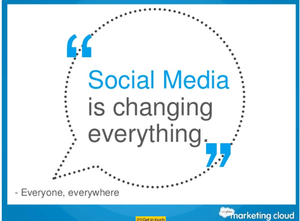Social media is ingrained in contemporary life – from publishing life happenings and posting our thoughts in a collective stream of consciousness to looking up user reviews and checking-in to our favorite destinations.
Since the introduction of social media, the world has become smaller, making it easier than ever to find and share information, as well as personal or professional interests, with the rest of the world. And, with the latest advances in social media interaction – as well as with new technologies like Google Glass and other wearable technology – unprecedented opportunities for communication and commerce have arisen.
Social media first started to gain some ground in the business world right around 2008, when companies realized that it could be leveraged for marketing and customer relations. And those that were embracing social media to build their brands in this new landscape of status updates, tweets, pins, and more created interactions and brand advocates that they never would have seen otherwise.
Take Ford Motor Company for example. Who would have ever thought that rebranding a vehicle on Facebook would have ever been as widely successful as social media director Scott Monty made it?
But, not surprising to most of the readers here, entrepreneurs are keen at spotting those opportunities that exist in the new emerging layers of business, and one of those layers is beginning to emerge before our very eyes.
Human Media as the New Layer of Social
At one point, it was easy to say that Facebook changed business forever; however, today, businesses can go a step further and social media to grow their audience by connecting with them on a more visceral level through real engagement. What is real engagement? Real engagement is using face to face contact, viewing facial expressions and hand movements that add a human component to a brand, making the brand less corporatized.
When users connect with a brand instead of a person that relationship feels commercial to the customer; however, if people are involved, a bond of trust is formed. Each respective social media platform has its strengths and weaknesses, but for brands looking to excel with real engagement, look no further than Google+.
Google+ is a social platform with a layer of what’s called Human Media. Human Media is social media via webcam. So instead of brands just interacting with customer’s profile pictures in the comments section of posts, companies are actually talking to their followers face to face in group video chats called Hangouts.
Other platforms that incorporate Human Media involve Spreecast, Zarfor and Oovoo; however, while all of these platforms are bringing people together for real-time conversation over that of asynchronous text-based comments, they cannot perform to the scale of Google+ Hangouts.
Using Human Media for Business Goals
Hangouts can transform every type of business – especially customer service, human resources, product demonstration, sales and even the travel industry. For example, my work with Veterans Virtual Tours has allowed a countless number of terminally ill and aging veterans to view monuments dedicated to their service. And, with Google Glass, I am even able to give them a first person perspective.
Other Google Plussers have begun using Hangouts for ecommerce, using the service for cooking lessons, yoga classes and even tax services. And, while ecommerce is in its infant stage with Hangouts, the potential for growth is extraordinary, even leading to the possibility of a program that is reportedly named “Helpouts” that allows individuals, small and large businesses to buy and sell services via live video.
With the few examples listed above, countless others are popping up all over the world. One method of harnessing these ideas for future inspiration has been through the Google+ Human Media Movement Community. In the community, members post their thoughts on Human Media and ways real-time communication is transforming the way we think.
Create and Share Great Content
Next to the human factor, content runs social media. It’s about sharing everything from stories relevant to the company, its customers and industry. Perhaps your company is raising money for a charity event. The event would be posted on Facebook and shared within the brand’s community. That same message will be tweeted out on that network, cross-pollinating the event on all channels. During the event, the company could host a Hangout on Google+ bringing individuals face to face with its happenings. During the event, pictures will be tweeted with a unique hashtag as well as posted to Instagram, and, if a photo isn’t enough, short videos can also be captured on Vine.
As businesses around the world continue to grow using social media and now Human Media to connect with their customers and build their brands, the future of commerce is using social networking to reduce the physical space between you and your following. What lies on the frontier could be determined by advances in technology like wearable computers, group video chat and augmented reality. In the meantime, businesses are wading deeper into the social stream hoping it will pay dividends.
How does your business plan to spend its social cache?
Sarah Hill is the Chief Digital Storyteller for Veterans United Home Loans, where she is Hangout Host for its veteran and military issues news hub, Veterans United Network.
Image Credit: http://blogs.salesforce.com





